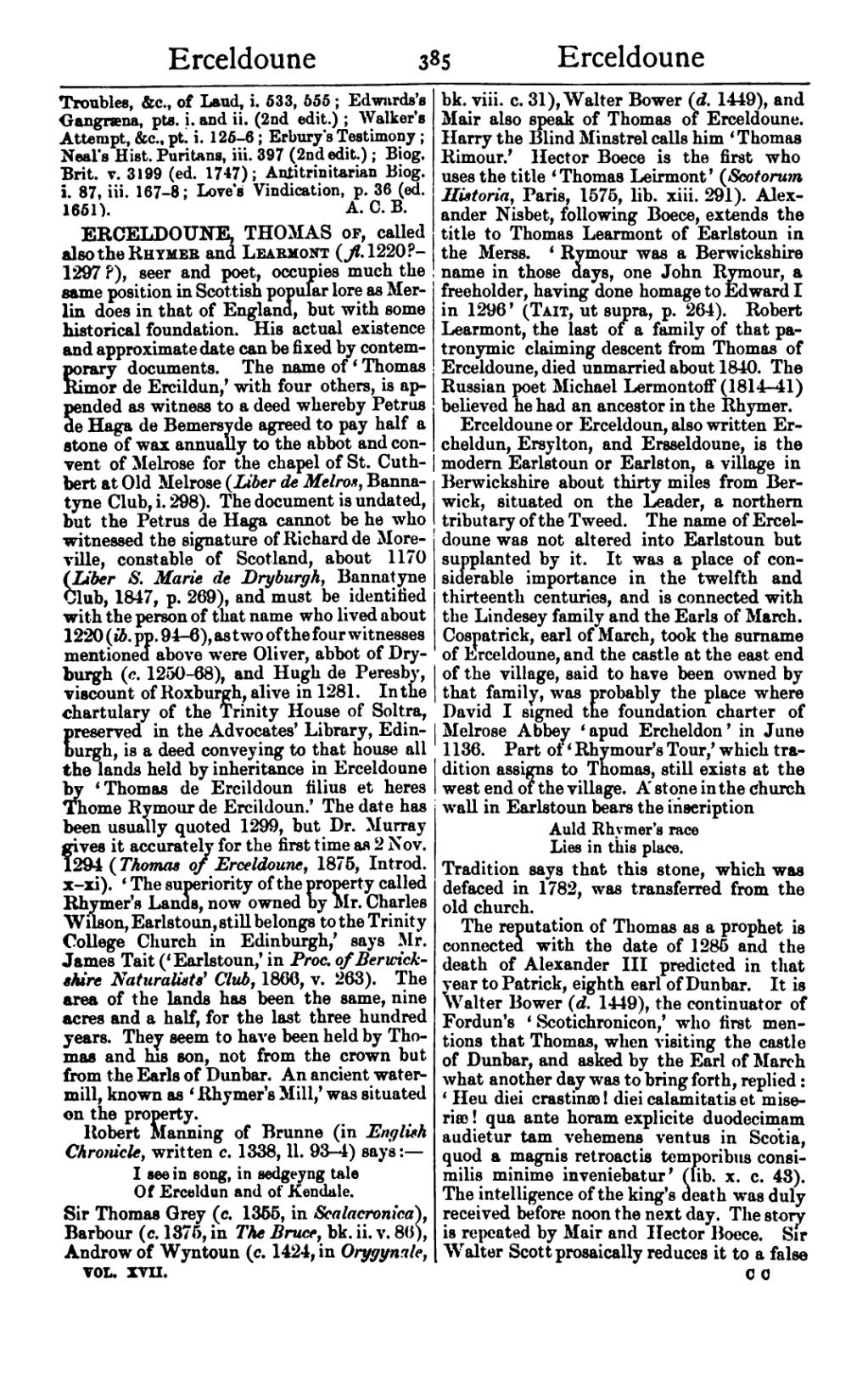ERCELDOUNE, THOMAS of, called also the Rhymer and Learmont (fl. 1220?–1297?), seer and poet, occupies much the same position in Scottish popular lore as Merlin does in that of England, but with some historical foundation. His actual existence and approximate date can be fixed by contemporary documents. The name of ‘Thomas Rimor de Ercildun,’ with four others, is appended as witness to a deed whereby Petrus de Haga de Bemersyde agreed to pay half a stone of wax annually to the abbot and convent of Melrose for the chapel of St. Cuthbert at Old Melrose (Liber de Melros, Bannatyne Club, i. 298). The document is undated, but the Petrus de Haga cannot be he who witnessed the signature of Richard de Moreville, constable of Scotland, about 1170 (Liber S. Marie de Dryburgh, Bannatyne Club, 1847, p. 269), and must be identified with the person of that name who lived about 1220 (ib. pp. 94–6), as two of the four witnesses mentioned above were Oliver, abbot of Dryburgh (c 1250–68), and Hugh de Peresby, viscount of Roxburgh, alive in 1281. In the chartulary of the Trinity House of Soltra, preserved in the Advocates' Library, Edinburgh, is a deed conveying to that house all the lands held by inheritance in Erceldoune by ‘Thomas de Ercildoun filius et heres Thome Rymour de Ercildoun.’ The date has been usually quoted 1299, but Dr. Murray gives it accurately for the first time as 2 Nov. 1294 (Thomas of Erceldoune, 1875, Introd. x–xi). ‘The superiority of the property called Rhymer's Lands, now owned by Mr. Charles Wilson, Earlstoun, still belongs to the Trinity College Church in Edinburgh,’ says Mr. James Tait (‘Earlstoun,’ in Proc. of Berwickshire Naturalists' Club, 1866, v. 263). The area of the lands has been the same, nine acres and a half, for the last three hundred years. They seem to have been held by Thomas and his son, not from the crown but from the Earls of Dunbar. An ancient water-mill, known as ‘Rhymer's Mill,’ was situated on the property.
Robert Manning of Brunne (in English Chronicle, written c 1338, ll. 93–4) says:—
I see in song, in sedgeyng tale
Of Erceldun and of Kendale.
Sir Thomas Grey (c. 1355, in Scalacronica), Barbour (c. 1375, in The Bruce, bk. ii. v. 86), Androw of Wyntoun (c. 1424, in Orygynale, bk. viii. c. 31), Walter Bower (d. 1449), and Mair also speak of Thomas of Erceldoune. Harry the Blind Minstrel calls him ‘Thomas Rimour.’ Hector Boece is the first who uses the title ‘Thomas Leirmont’ (Scotorum Historia, Paris, 1575, lib. xiii. 291). Alexander Nisbet, following Boece, extends the title to Thomas Learmont of Earlstoun in the Merss. ‘Rymour was a Berwickshire name in those days, one John Rymour, a freeholder, having done homage to Edward I in 1296’ (Tait, ut supra, p. 264). Robert Learmont, the last of a family of that patronymic claiming descent from Thomas of Erceldoune, died unmarried about 1840. The Russian poet Michael Lermontoff (1814–41) believed he had an ancestor in the Rhymer.
Erceldoune or Erceldoun, also written Ercheldun, Ersylton, and Ersseldoune, is the modern Earlstoun or Earlston, a village in Berwickshire about thirty miles from Berwick, situated on the Leader, a northern tributary of the Tweed. The name of Erceldoune was not altered into Earlstoun but supplanted by it. It was a place of considerable importance in the twelfth and thirteenth centuries, and is connected with the Lindesey family and the Earls of March. Cospatrick, earl of March, took the surname of Erceldoune, and the castle at the east end of the village, said to have been owned by that family, was probably the place where David I signed the foundation charter of Melrose Abbey ‘apud Ercheldon’ in June 1136. Part of ‘Rhymour's Tour,’ which tradition assigns to Thomas, still exists at the west end of the village. A stone in the church wall in Earlstoun bears the inscription
Auld Rhymer's race
Lies in this place.
Tradition says that this stone, which was defaced in 1782, was transferred from the old church.
The reputation of Thomas as a prophet is connected with the date of 1285 and the death of Alexander III predicted in that year to Patrick, eighth earl of Dunbar. It is Walter Bower (d. 1449), the continuator of Fordun's ‘Scotichronicon,’ who first mentions that Thomas, when visiting the castle of Dunbar, and asked by the Earl of March what another day was to bring forth, replied: ‘Heu diei crastinæ! diei calamitatis et miseriæ! qua ante horam explicite duodecimam audietur tam vehemens ventus in Scotia, quod a magnis retroactis temporibus consimilis minime inveniebatur’ (lib. x. c. 43). The intelligence of the king's death was duly received before noon the next day. The story is repeated by Mair and Hector Boece. Sir Walter Scott prosaically reduces it to a false
